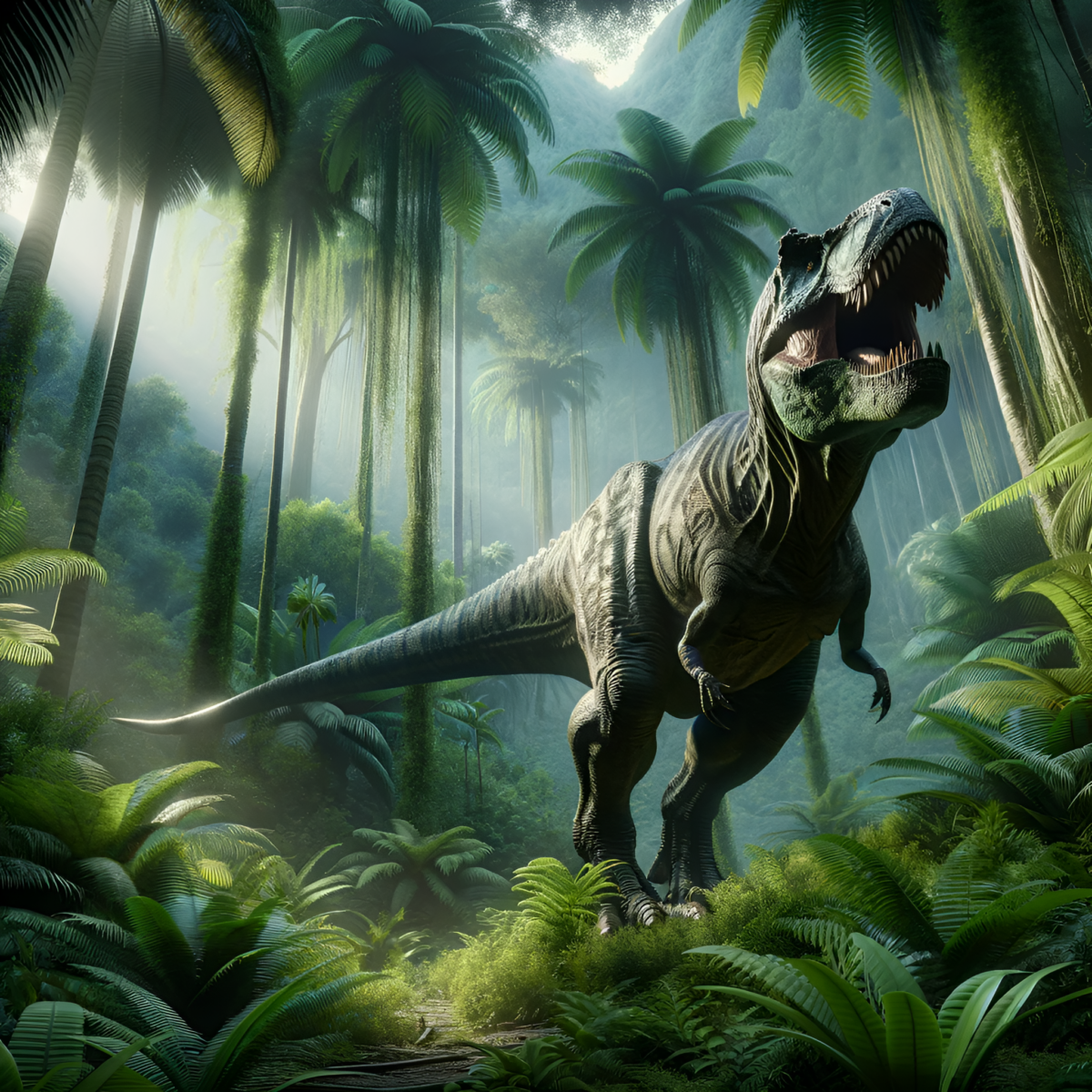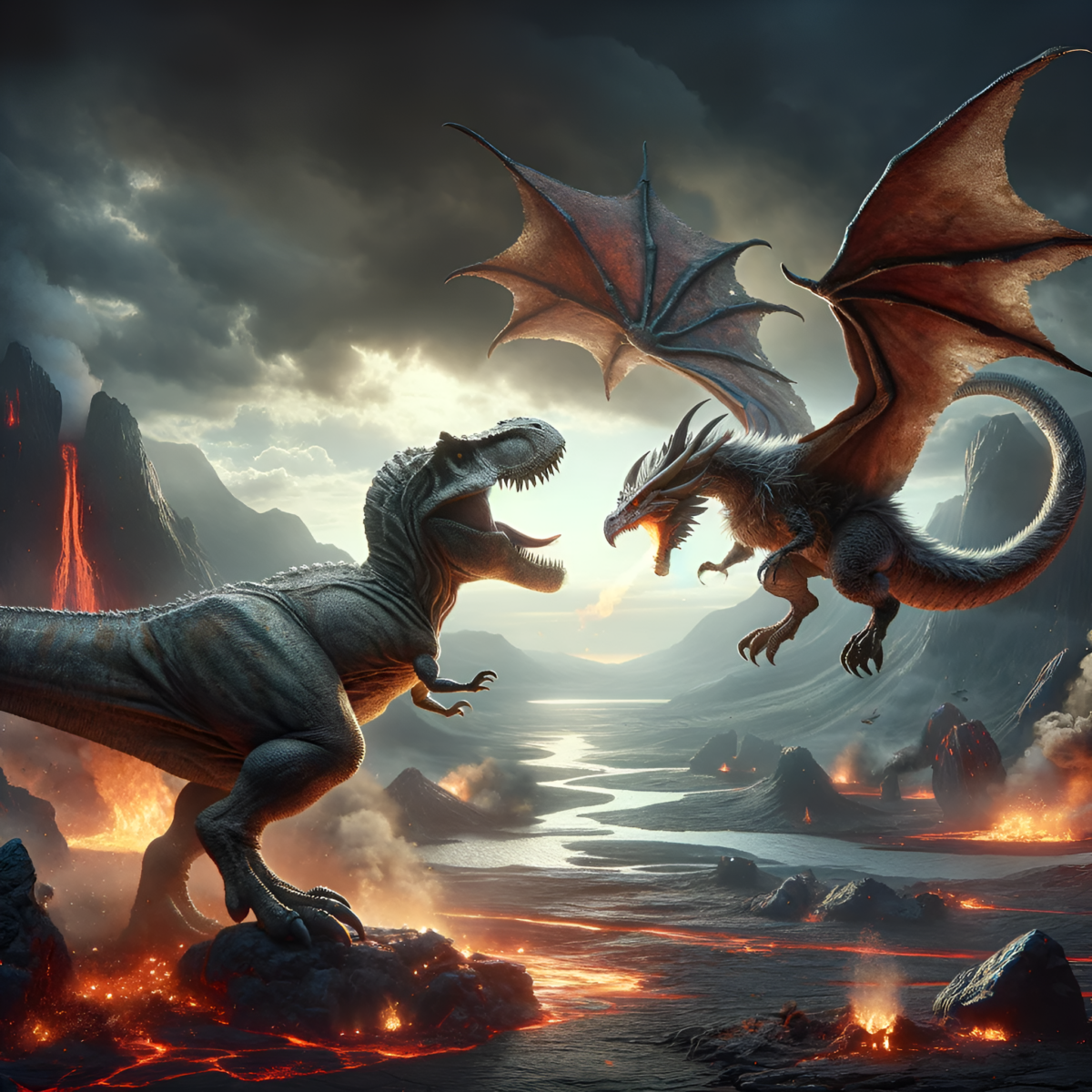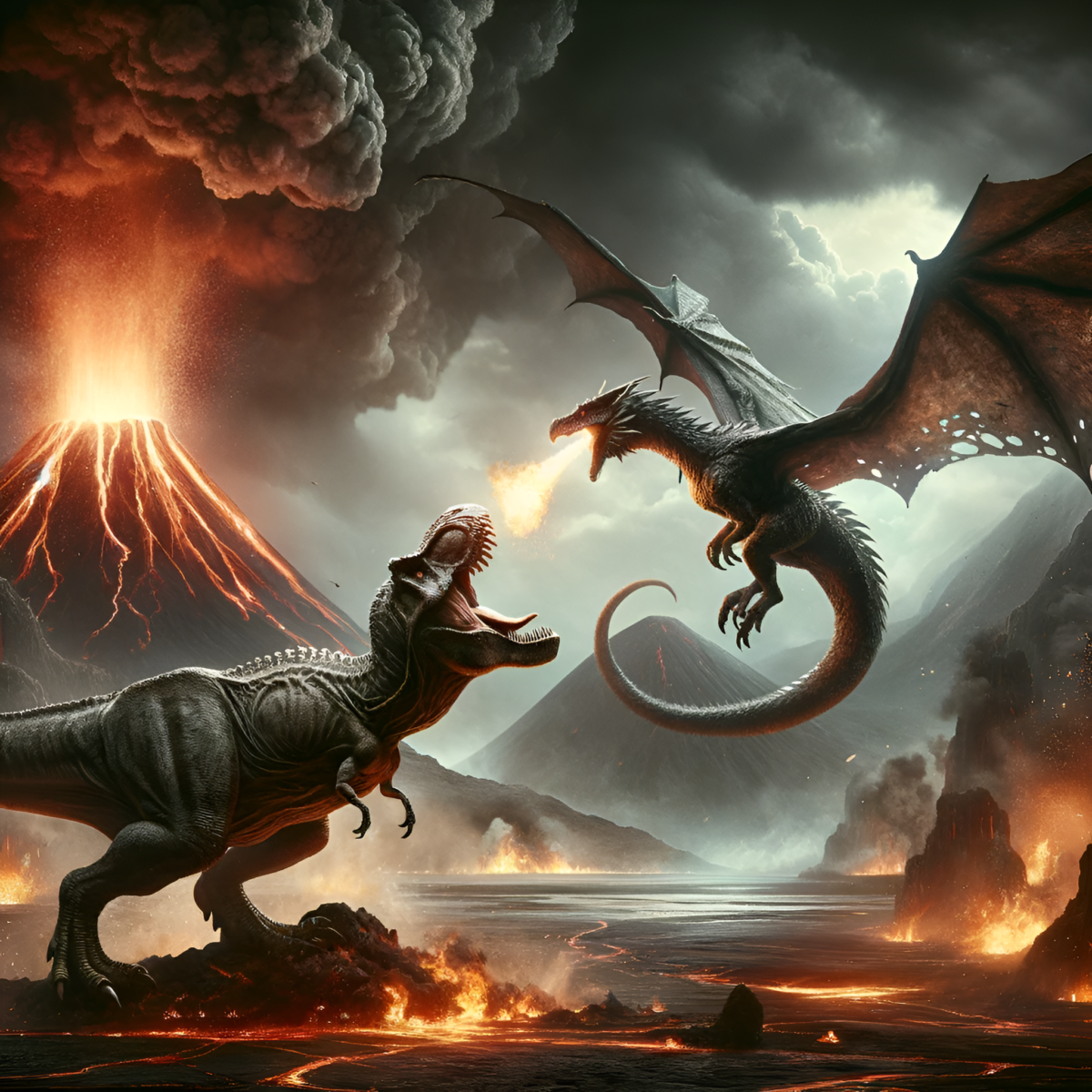In the world of mythical and prehistoric creatures, few beings capture our imagination quite like dragons and the mighty Tyrannosaurus Rex. An epic confrontation between these two titans sparks endless speculation and debate among enthusiasts. But without time machines or magic portals, we can only rely on available data and historical records to make a well-educated guess on the outcome of such a battle.
Drawing from scientific research, folklore, and popular media, let’s analyze the strengths and weaknesses of both the T-Rex and dragons to determine which creature holds the advantage. Although dragons inhabit the realm of myths and legends, their traits can be compared to the T-Rex, a real predator that once stalked the Earth millions of years ago. While both competitors share certain attributes, such as ferocity and hunting prowess, they also exhibit unique characteristics that could tip the scales in their favor.
Key Takeaways
- T-Rex and dragons both possess formidable physical attributes and hunting skills
- Comparing their defense mechanisms, intelligence, and social behavior helps identify the key factors in their hypothetical confrontation
- Though the outcome of such a battle remains speculative, examining these factors allows for educated guesses about who would win.
Table of Contents
Comparison
When comparing a T-rex and a dragon, it is essential to consider the known facts about the Tyrannosaurus rex and the mythical characteristics attributed to dragons. T-rex was a real dinosaur that lived approximately 68-66 million years ago, while dragons are fictional creatures often depicted in folklore and popular culture.
The fossil records of Tyrannosaurus rex provide us with factual data about its size, weight, and physical traits. Adult T-rex’s were massive, with an estimated height of around 12 feet at the hips and a length of 40 feet from head to tail. The weight of these gigantic reptiles could reach up to 9 tons. The T-rex was a bipedal creature, with its two massive legs supporting its enormous body, and it moved in bounding steps. One of its most distinctive traits was its short arms, which were tiny compared to its massive head and jaws.
As for dragons, they come in various shapes, sizes, and forms in different mythologies. For the sake of this comparison, let’s focus on a basic understanding of dragons: quadrupedal, reptilian creatures with wings, allowing them to fly. The size and weight of a dragon can vary greatly depending on the story. However, most often, they are depicted as having a massive size advantage over most other creatures.
In terms of movement type, T-rex was a ground-based predator that relied on its powerful legs and keen senses to hunt its prey, whereas dragons can crawl and walk on the ground but are primarily known for their flying capabilities. The eyesight and hearing of a T-rex were both acute, helping it to detect and track potential prey. Dragons are often described as having excellent vision as well, but specific details about their hearing are not typically mentioned in folklore.
Comparing physical traits, both T-rex and dragons share some reptilian features. However, the key differences lie in their limbs, with T-rex having short arms and dragons having four legs and wings for flight. While the massive head and jaw of a T-rex possess remarkable strength, dragons are often portrayed with powerful jaws and sharp teeth capable of causing significant damage as well. Additionally, some dragon myths depict them as being able to breathe fire, further setting them apart from any known real-life animals.
In a hypothetical fight between a Tyrannosaurus rex and a dragon, one could argue that the dragon’s ability to fly would give it an advantage over the ground-dwelling T-rex. Moreover, if the dragon could breathe fire, it would have a significant offensive weapon against the dinosaur.
However, it is essential to remember that comparing these two creatures is ultimately a speculative exercise, as dragons are mythical beings while T-rex was a real dinosaur. Therefore, any conclusions drawn would be based on the imaginative world of folklore and not grounded in reality.
Physical Characteristics
The physical characteristics of a Tyrannosaurus rex and a dragon play a significant role in determining the outcome of their hypothetical battle.

The T. rex was a powerful dinosaur possessing a massive head and serrated teeth that were designed for gripping and tearing flesh. Despite having relatively short arms, these formidable predators relied heavily on their powerful jaws to subdue their prey. As a bipedal reptile, T. rex was capable of standing and walking on two legs, which allowed it to cover large distances in search of food. Their thick skin may have provided some level of physical protection against certain threats.

On the other hand, depictions of dragons vary across different cultures and mythologies, yet they are commonly portrayed as large, powerful reptiles with sturdy scales or osteoderms that cover their bodies. These strong scales and hard skin probably act as effective physical defenses against potential attackers. Dragons can be depicted as either quadrupedal or bipedal creatures, with some even having the ability to fly, which grants them an advantage in terms of mobility and agility.
In terms of physical size, mythical dragons often surpass the T. rex. While the T. rex typically measured around 40 feet in length and weighed between 7 to 9 tons, dragons have been described in various sizes, with some being much larger than the T. rex.
Diet and Hunting
Comparison Table
| Tyrannosaurus Rex | Dragon | |
|---|---|---|
| Prey | Herbivorous dinosaurs, small carnivores, scavenging opportunities | Varies based on folklore or species |
| Hunting Strategy | Ambush predator, opportunistic scavenger | Varies based on species (fire-breathing, aerial strikes, etc.) |
| Attack Method | Jaws with powerful bite force, knock down victims with weight | Varies based on species (fire, teeth, claws, tail) |
| Preferred Environment | Late Cretaceous period, western North America | Different, depending on the legend or fictional world |
The Tyrannosaurus rex was a formidable predator during the Late Cretaceous period in western North America. As an ambush predator, T. rex relied on its powerful jaw and sharp teeth to target vital areas of its prey, which included herbivorous dinosaurs and smaller carnivores. However, T. rex was also an opportunistic scavenger, taking advantage of carcasses when available.
Dragons, on the other hand, are highly diverse creatures in mythology and fiction. While some are depicted as fire-breathing monsters that hunt prey from the sky, others show more serpent-like qualities or incorporate elements from various creatures. As such, dragons’ preferred prey and hunting strategies may vary greatly, depending on their specific abilities and the conditions of their habitats.
Ambush tactics are crucial for both T. rex and many dragons in their respective niches. While the T. rex’s massive weight and powerful jaws would have allowed it to knock down opponents and target vital areas, dragons may possess additional advantages, such as flight, fire-breathing, and other special abilities.
Defense Mechanisms
In a hypothetical battle between a Tyrannosaurus rex and a dragon, defense mechanisms play a crucial role in analyzing their chances of survival. The T. rex, a well-known prehistoric predator, possesses several physical attributes that contribute to its defense and offensive capabilities.
First and foremost, the T. rex’s teeth and powerful bite are among its primary weapons. The T. rex had a jaw structure capable of bone-crushing bites, applying tremendous force to incapacitate its prey. This powerful bite, coupled with its large, razor-sharp teeth, made T. rex one of the fiercest predators during its time.
The dragon, on the other hand, is a mythical creature whose abilities and characteristics can vary widely depending on its interpretation. However, common depictions of dragons often include venomous fangs or even the ability to breathe fire. These features can serve as both offense and defense mechanisms, allowing the dragon to attack from a distance or defend itself from approaching threats.

In terms of physical defenses, the T. rex had a thick, muscular build that provided some resistance against attacks from other prehistoric creatures. Additionally, its hard skin may have offered limited protection against bites and claw strikes. Although not a traditional defense mechanism, the T. rex’s sheer size and strength likely deterred many potential predators.
Dragons, by contrast, frequently have scales and protective armor covering their bodies. This external shielding can be incredibly tough, providing substantial defense against physical attacks. Some depictions of dragons even include spines, barbs, or other protrusions that could further enhance their defense capabilities.
Intelligence and Social Behavior
The intelligence and social behavior of both Tyrannosaurus rex and dragons can significantly impact their likelihood of winning in a hypothetical encounter.
Tyrannosaurus rex is known to be an ambush predator that relied on hunting tactics and terrestrial navigation to catch prey. Its intelligence may have contributed to its ability to strategize and execute ambush tactics. On the other hand, dragons, as depicted in mythology and popular culture, are often portrayed as highly intelligent creatures with the capability to think and communicate complex ideas. However, an accurate comparison in intelligence between T. rex and dragons is speculative since dragons are fictional creatures.
When it comes to social behavior, T. rex is thought to be a solitary creature that mainly interacted with its own species for the purpose of mating or competition. Adult T. rex were possibly territorial, which signifies that they guarded their territories against rivals and engaged in confrontations if necessary. Dragons, in contrast, are often depicted as having varying social behaviors, ranging from reclusive to highly social in their communities. In some interpretations, dragons are shown to have complex social hierarchies that require intelligence and cooperation.
Taking into account the roles of intelligence and social behavior, T. rex’s likelihood of success in an encounter with a dragon may be influenced by their territorial instincts and cunning as an ambush predator. Their experience in navigating and surviving in the terrestrial environment could also provide them with an advantage. Conversely, dragons may rely on their mythical intellect and, in some cases, their social behavior to outwit or overpower a T. rex.
In this hypothetical scenario, the outcome of a T. rex vs. dragon encounter would depend on various factors such as their respective intelligence levels, social behavior, and individual abilities like strength, speed, and adaptability in the confrontation. It is important to note that the analysis is limited due to the fictional nature of dragons, but it highlights the potential for interesting battle dynamics between these two iconic creatures.
Key Factors
When comparing a Tyrannosaurus rex and a mythical dragon in a hypothetical battle, several factors must be considered. One of the primary aspects to examine is their teeth and bite. T. rex is known for its powerful bite, which was capable of delivering bone-crushing bites thanks to its immense jaw strength. On the other hand, dragons are often depicted with sharp, elongated teeth, which could potentially pierce through tough skin.
Size is another crucial element to compare. While the exact size of a dragon may vary depending on the myth or legend, most depictions show them as significantly larger than T. rex. A typical Tyrannosaurus rex measured about 40 feet in length, while dragons often are portrayed as longer and sometimes even more massive creatures.
Another key factor is the presence of venom or other special abilities. While T. rex did not possess any venomous capabilities, dragons are usually depicted with either venomous bites or the ability to breathe fire. These abilities can greatly contribute to the dragon’s offensive potential in a battle.
Physical defenses also play a role in determining the outcome of a battle. The T. rex had thick, sturdy bones and a muscular build, which could offer some protection against attacks. Although details may vary, dragons are often portrayed with hard scales covering their bodies, providing them with an added layer of defense. Additionally, some depictions of dragons include sharp spines, horns, or other physical features that can be used defensively or offensively.
Who Would Win?
Attempting to compare the fighting prowess of a T-Rex, a legendary dinosaur, and a dragon, a mythical creature, poses an intriguing challenge. Both have fascinated audiences for ages, whether in paleontological circles or in the realm of fantasy. In this section, we’ll analyze their respective strengths and weaknesses to see how they might fare in a hypothetical battle.

A Tyrannosaurus rex was a massive, bipedal dinosaur that dominated the late Cretaceous period approximately 68 million years ago. It is regarded as one of the fiercest predators of its time, possessing razor-sharp teeth and averaging lengths between 40 to 43 feet. In addition, T-Rex had a powerful bite force that could crush bones and tear flesh. Despite their notoriously short arms, T-Rexes could use their immense body mass and strong legs to deliver devastating attacks. It’s important to note that while the T-Rex was a real animal, its exact fighting style and capabilities are still a subject of ongoing scientific debate.
In sharp contrast, dragons are mythical creatures that have appeared in various cultural folklore for centuries. Their traits and abilities vary across different stories— some dragons can fly, while others are relegated to the ground; some can breathe fire, others might control ice or have other magical powers. Despite these variations, dragons generally possess extraordinary physical strength, agility, and a natural affinity for combat. As mythical creatures, dragons are not restricted by the same constraints of reality that a T-Rex would face.
When evaluating the T-Rex against a dragon in battle, we must consider several factors. If the dragon is capable of flight, it would have an inherent advantage over the grounded T-Rex, as it could unleash aerial attacks and evade retaliation. Similarly, if the dragon possesses ranged abilities, like the iconic fire-breathing, it could inflict damage from a distance without engaging directly in combat. However, if the dragon is grounded and lacks ranged abilities, it would have to rely on its strength, natural weaponry, and agility to ward off the T-Rex’s powerful bite and crushing attacks.
Outside of sheer physical strength, another factor to consider is the Komodo dragon, a living modern-day reptile. These creatures possess venomous saliva, containing anticoagulant properties that can cause infections and extensive blood loss in their prey. While Komodo dragons are much smaller than either a T-Rex or a mythical dragon, their venomous trait highlights a possible advantage for our hypothetical dragon – if their saliva or other secretions were similarly toxic, this could further tip the scales in their favor.
In the end, as a confrontation between a T-Rex and a dragon remains purely speculative, it’s impossible to definitively declare a winner. Many factors, such as the type of dragon, its specific abilities, and the environment in which the battle takes place, would play a significant role in determining the outcome.
Frequently Asked Questions
Are dragons superior in strength to T-Rex?
While dragons are mythical creatures and their strength varies across different stories, the T-Rex was a real dinosaur with immense strength and power. Comparing their strength is hypothetical as dragons’ abilities are often fantastical and not based on scientific facts.
Can a mythical dragon defeat a real dinosaur?
As dragons are mythical creatures, their abilities and strengths often surpass those of real-life animals such as dinosaurs. A battle between a dragon and a dinosaur like a T-Rex would be purely speculative and dependent on the specific characteristics attributed to the dragon in question.
Who wins in a battle between T-Rex and Spinosaurus?
Comparing the abilities of a T-Rex and a Spinosaurus is challenging since both were formidable predators. While the T-Rex is known for its massive skull and bulky build, the Spinosaurus was characterized by its elongated snout and formidable spines. The outcome of a battle between the two would depend on various factors, such as size, strength, and fighting techniques.
Is there any credibility to the T-Rex being a dragon theory?
The T-Rex is a scientifically verified dinosaur species, while dragons are mythical creatures. There is no credible evidence to support any theory that T-Rexes were real-life dragons or that the legend of dragons was based on the T-Rex specifically.
What animal could potentially defeat a T-Rex in combat?
Defeating a T-Rex in combat would require a formidable opponent. It’s possible that other large predators, such as the Spinosaurus or packs of smaller, agile predators like the Velociraptor, could have posed a threat to the T-Rex. However, it is important to note that these confrontations are speculative and might not have occurred due to differences in habitat and time periods.
Are dragons real or just a myth?
Dragons are mythical creatures that have been part of human folklore and mythology for centuries. There is no scientific evidence to suggest that dragons ever existed as real creatures. Their existence remains purely within the realms of legend and imagination.


